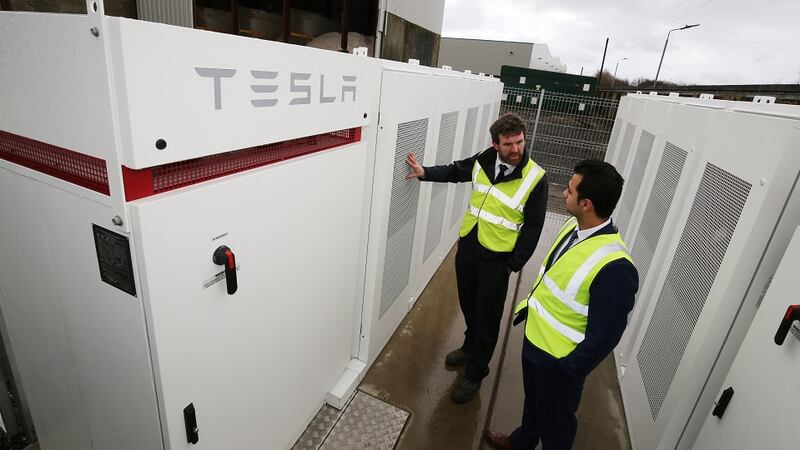ESB’s Smart Energy Services has partnered with Ardagh Group to provide a battery storage solution which protects its glass plant in Irvine, Scotland from power dips and outages whilst helping to balance the UK National Grid.
Glass manufacturing plants and their equipment require round-the-clock cooling in order to remain operational. Ardagh Group’s Irvine plant is located in an area where the electricity grid is subject to power dips – or brownouts as they are known in the industry. The company required a back-up power source which would enable it to ride out these dips and maintain critical systems.
ESB’s Smart Energy Service battery solution not only met Ardagh Group’s needs but also helps solve the grid’s balancing problems at the same time.

Tesla battery
ESB designed, installed and funded the 2-megawatt Tesla battery solution. Ardagh uses the battery whenever it needs to manage its energy consumption during peak periods while ESB’s Smart Energy Services uses it at other times to sell frequency services to balance the grid.
"ESB fund the battery installation and the costs are paid back over a few years by earnings through the grid," explains Tom Mooney customer flexibility manager, Smart Energy Services at ESB

Mooney expects projects of this nature to become increasingly common due to fundamental changes in the nature of power grids and the relationships between generators and electricity users.
He points to the state-wide electricity blackout in South Australia in 2016 as an example of the changing nature of electricity networks as more renewable energy is integrated on the grid. Electricity from renewable and conventional sources is not the same, renewables providing intermittent supply while conventional generation provides continuous supply, he explains.
And this matters because electricity grids have to be maintained at a continuous frequency to operate properly. A drop of even a few per cent can result in the entire grid blacking out – as happened in South Australia when the network was damaged by a storm.
“Tesla installed an expensive 100 MW battery farm in South Australia to provide back-up in the event of another blackout like this,” says Mooney.
We see batteries located at individual customers' premises as a more cost-effective way to deal with potential blackouts and network operators around the world are now incentivising customers to adopt battery solutions.
Renewables
Mooney points out that Ireland is very advanced when it comes to the integration of renewables onto the grid, but this has presented its own challenges. “EirGrid has had to set a limit of 65 per cent on the amount of renewable power on the grid at any one time. If we had customers with batteries in Ireland similar to Ardagh in Irvine, the grid could go above the current 65 per cent limit.”
We are going into customers' premises to provide win-win-win solutions for them, for us, and for the grid
The changing nature of relationships with customers is also a key driver. “In the past, utilities were power generators and maybe owned the wires that carried it, but they didn’t get very involved in what customers did with the power. That is changing now, and we are working closley with large users of energy to offer solutions that drive energy efficiency and cost savings for our customers.
The electricity market is changing
With the Irish launch on October 1st of ISEM (Integrated Single Energy Market), the market is primed so that business customers will in the future be able to sell energy balancing frequency services back to the grid as well as make revenues from shifting their energy load and consumption, similar to what is being offered in Great Britain today.
The solution provided by ESB to Ardagh Group in Irvine offers the company security of supply, the potential to lower electricity bills, and support in reducing its environmental impact. “The customer uses the battery during winter peaks,” Mooney notes. “They can charge it up during low demand periods and then use it during peak demand. They can also use it to maintain power during brownouts.”
By managing their electricity use in this way, they can choose to charge up the battery with renewable energy thereby reducing their dependence on the grid and reducing environmental impact.
At the same time the battery is helping to balance the grid and earning enough to pay for itself over time.
“We are going into customers’ premises to provide win-win-win solutions for them, for us, and for the grid,” Mooney concludes. “We have moved into a different world.”










